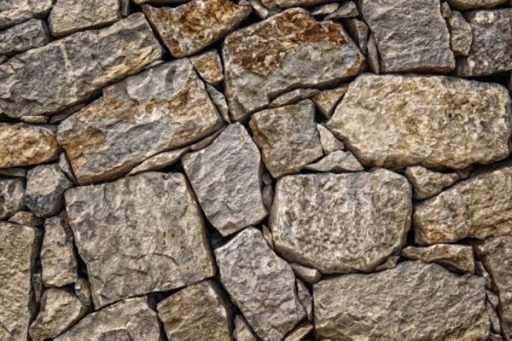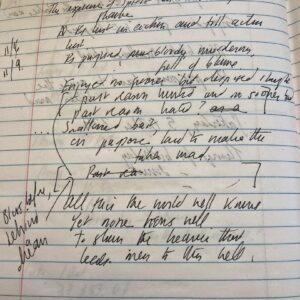Shortly after I arrived in Ithaca, New York—a newly-admitted MFA candidate in the Cornell University writing program—I attended a poetry reading by A. R. Ammons at a downtown bookstore. It was 1974, and Ammons read from his Collected Poems, 1951-1971, which had won the 1973 National Book Award for Poetry.
To begin, he held up the volume and pinched between his fingers the pages of the book’s first half. “I’m going to read from this part of the book,” he said. “You don’t need to bother with the second half, after I lost my religion.”
I would come to know the man’s winking self-deprecations, cagey ironies, and his sense of humor. He was a complicated guy. I read both halves of his prizewinning book, the soaring visionary mode of the earliest work modulating into the later, more self-conscious mixture of vocabularies and perspectives.
Often the poems are walks, sometimes even flights swinging from mountaintop to valley, tempted by an airy, eternal One but descending always to the embodied Many. Resting places are temporary. Wisdom, finally, is to remain in motion. What is fixed fails, the victim of time or human conflict.
Two poems, in particular, have stayed with me as touchstones for over thirty years, the much-anthologized “Corsons Inlet” and his lesser-known poem on the nature of thought, “The Misfit.” These poems seem important to me as warnings against the rigidity of a closed mind.
“The Misfit” describes dialectic thought; it could serve as brief allegory for how science works, reasoning up from observation.
The unassimilable fact leads us on: round the edges where broken shapes make poor masonry the synthesis fails (and succeeds) into limitation or extending itself too far becomes a different synthesis….
The temporary “success” of “limitation”—resistance to new data— is doomed. The misfit fact out at the ragged edge of things troubles thought into a larger satisfaction. By the misfit fact
…we are led on to peripheries, to the raw blocks of material, where mortar and trowel can convert diversity into enlarging unity:
The periphery is where the action is, where the material is raw, unworked, irregular. Mortar and trowel can convert diversity into an enlarged unity, but not when given a pile of identical bricks. It is…
not the million oriented facts but the one or two facts, out of place, recalcitrant, the one observed fact that tears us into questioning:
Because the misfitting fact is inconvenient, we must be torn into questioning. And this is the way of empiricism, as opposed to “top-down” reasoning in which an orthodox template dictates correct conclusions. Ammons in “The Misfit” stands with Galileo, not with those who imprisoned him, for finding moons circling Jupiter, shattering the crystalline symmetries of the Earth-centered universe.
And then, in its last stanza, the poem takes a surprising turn in its language:
what has not joined dies into order to redeem, with loss of singleness extends the form, or, unassimilable, leads us on.
Ammons, at the end of his poem, sounds a religious note when he says that the misfit fact “dies into order to redeem.” The singular fact can only extend the form by “dying” into conformity, a process which enlarges the structure that must accommodate it. And the religious allusion is itself a surprise, an oddity that leads on to further implications.
The allusion is to Psalm 118 with the famous verses (22-23) referenced by Jesus in the gospels of Matthew and Mark. The Psalm says: “The stone which the builders refused is become the head stone of the corner. This is the Lord’s doing; it is marvelous in our eyes.” And so the poem ends with the unassimilable, misfitting piece elevated to the status of cornerstone for a new structure.
Ammons’s poem reminds me of the analysis of desire in Augustine’s Confessions, in which human longing searches the world restlessly and endlessly for an object adequate to its desire, until finally it is led from the temporal to the eternal. This is also the way of “negative theology,” which avoids hubristic certainty by critiquing our conceptions of God.
This open and endless pursuit also reminds me that the Navajo word for “sand painting” means “place where the gods come and go,” and that the painting’s border always includes a break for that coming and going. Furthermore, when the ritual has been finished the painting must be swept away, not clung to like an idol.
“Corsons Inlet,” perhaps Ammons’s best-known poem, expresses in its own way the liberation that comes with intellectual humility. The poet walks along the Jersey shore, observing the complexities of life there, relieved by the way its “hues, shadings, rises, flowing bends and blends of sight” have freed him from “the perpendiculars, straight lines, blocks, boxes, binds of thought.” After describing darting minnows, flocking birds, the flux of weather and tides, he declares:
but Overall is beyond me: is the sum of these events I cannot draw, the ledger I cannot keep, the accounting beyond the account….
Amid nature’s fecundity and complexity, he can only conclude:
I have reached no conclusions, have erected no boundaries, shutting out and shutting in, separating inside from outside: I have drawn no lines: as manifold events of sand change the dune’s shape that will not be the same shape tomorrow…
He reacts to this limit upon his knowledge not with frustration, but with relief. It is a source of comfort to him. “[T]here is serenity,” the poet says, and even in the midst of competition and predation there is “no arranged terror: no forcing of image, plan, / or thought: / no propaganda, no humbling of reality to precept….” As in “The Misfit,” the facts of the world oppose “precept” and “propaganda.” There are “orders,” of course, but this poet “will / not run to that easy victory”:
still around the looser, wider forces work
I will try
to fasten into order enlarging grasps of disorder, widening
scope, but enjoying the freedom that
Scope eludes my grasp, that there is no finality of vision,
that I have perceived nothing completely,
that tomorrow a new walk is a new walk.
Ideologues and propagandists take the same walk every day, uninterested in “hues” and “shadings,” dismissing the “misfit” fact. And what of the rest of us these days when so many inhabit separate worlds of “fact” that barely overlap?
Robert Schultz is an exhibiting artist and the author of six books in three genres—most recently, Into the New World: Poems (Slant). He lives in Salem, Virginia.





